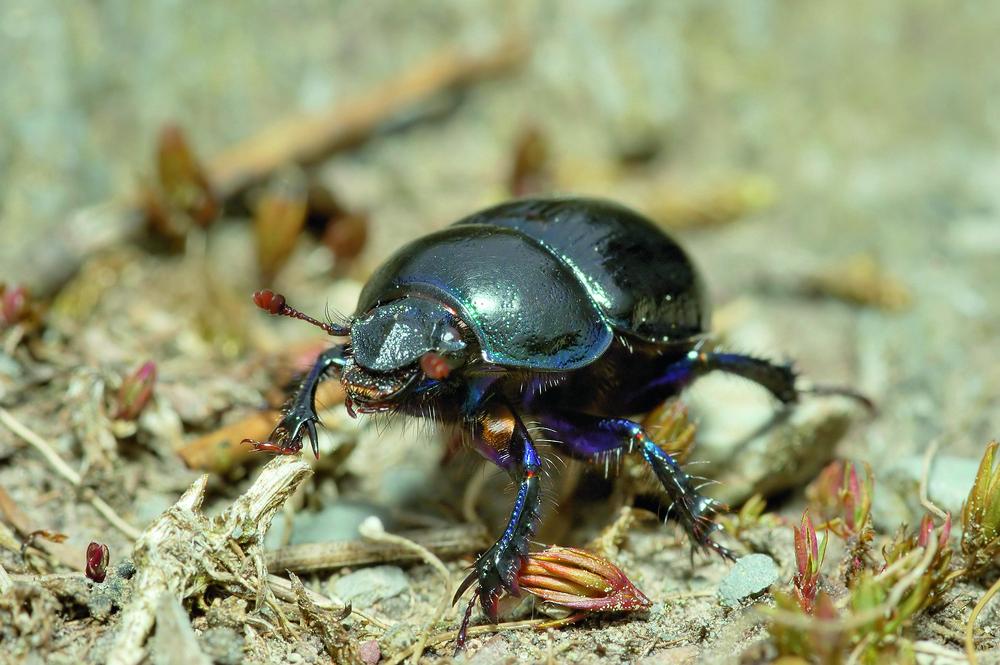Edward Andrews finds that ‘beetle mania’ is alive and well…
In November 2018, it was revealed that archaeologists working in Egypt had discovered a collection of mummified scarab beetles at the edge of a pyramid complex in the ancient necropolis of Saqqara, south of Cairo. While mummified human remains and sacrificial offerings such as cats are relatively frequently found in Egypt, the mummified beetles represent a rare and exciting discovery. Ancient Egyptians considered the beetles to be sacred.
Scarab beetles are a group consisting of a wide range of different beetle species. In the UK, there are over 100 species of stag beetle, chafer beetle and dung beetle in the group. It was the lowly dung beetle that was held in the highest regard by the ancient Egyptians. They roll large balls of dung and bury them. In much the same way, the ancient Egyptians believed that the sun god, Khepri, would roll the morning sun over the eastern horizon at daybreak so Khepri was often portrayed as a dung beetle in Egyptian artwork.
Ground work
One does not have to look too hard in our rural county to find a food source for dung beetles. The pastures in Jack’s Meadow at Severn Valley Country Park have been managed through sheep grazing for many years. Among the anthills and sheep droppings and against a broken winter sky of salmon pink, I dig some small holes and sink plastic pots into the ground, protected from the rain. These pitfall traps are a useful way of surveying ground beetles that wander the field by night. As I dig one of the holes, I spot a white grub in the soil. It has a distinctive brown head and powerful mouthparts. This is the larvae of a chafer beetle (also a type of scarab beetle). They eat plant roots and are classed as a pest. This creature will spend the winter buried in the soil and then hatch as an adult beetle next May.
Hall Close Coppice tumbles steeply down from Jacks Meadow to the river. Several streams have carved deep channels amongst the alder and hazel trees. Lying next to a path is a rotting oak branch. I can see the black fleshy stumps of dead man’s fingers, a type of deadwood fungi that is invading the log. I pull apart the fleshy wood and spot something black and shiny curled up within. I carefully lift out the beetle and put it into a collection pot. Back at home in the warm, the beetle starts to awaken from its winter slumber. I can see that it has long thin mouthparts. This is the snail-eating beetle and the mouthparts are adapted to poking into snail shells.
Finding a balance
The next morning, I return to check the pitfall traps in Jack’s Meadow. A large beetle has dropped into one of the traps overnight. At first glance, it looks superficially similar to the snail-eating beetle. Both match the ‘typical’ design of a beetle with a shiny blue-black body case and six legs. It is that archetypal design that is depicted in the artwork on the outside of the sarcophagus in which the mummified scarab beetles were found. The beetle in the trap is actually the black clock beetle, a common beetle in grasslands including gardens. This species will prey on invertebrates but also eats some plant material. They do not have the long thin mouthparts of the snail-eating beetle, but do have powerful mandibles.
Whether it is dung or deadwood, a universal theme with beetles is one of recycling. The action of both adult beetles and larvae helps to return vital nutrients to the soil. Unfortunately the actions of humans are starting to impact negatively on dung beetle populations. Worming drugs that are given to livestock persist in dung and poison invertebrates including beetles. The mummified beetles discovered in Egypt were around 6000 years old. Clearly, the ancient Egyptians all those years ago quickly recognised the importance of this fascinating group of insects and looked after them a little better than we are today. Research carried out by a scientist called Dr Sarah Benyon has calculated that dung beetles could save up to £367 million a year for the UK cattle industry by clearing up cow poo! Through her farm in Pembrokeshire, she is now supplying mail-order dung beetles to other farmers wishing to restore the balance to their land.
Do one thing for wildlife this month…
This winter, encourage beetles into your garden by introducing some deadwood. This could just be a pile of logs left to rot down in a quiet corner. Alternatively, why not bury a line of logs in the ground at various heights to give a bit more variety. Species such as the snail-eating beetle can have a really positive impact in terms of controlling snails that might otherwise damage your prize plants!






